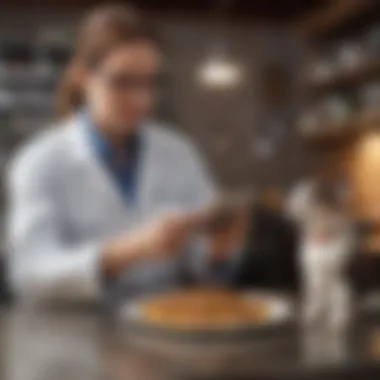Understanding High Oxalate Foods and Their Impact on Pet Health


Intro
Understanding the dietary needs of pets is crucial for maintaining their health and longevity. Pets, much like humans, require a balanced diet for optimal well-being. They can be sensitive to certain foods that may not affect us in the same manner. High oxalate foods are one category that can pose significant risks for pets, particularly concerning kidney health. Oxalates are naturally occurring compounds found in various foods and have the potential to lead to serious health issues if consumed in excess.
This article aims to elucidate the effects of high oxalate foods on pets. By highlighting the relationship between oxalate consumption and pet nutrition, it will serve as a valuable resource for pet owners. The significance of being aware of what goes into a pet's diet will be central to our discussion.
Moreover, we will include a detailed chart of foods rich in oxalates and offer practical advice on how to keep your pet's diet balanced and healthy. By understanding high oxalate foods, pet owners can make more informed dietary choices for their beloved companions.
Recognizing the broader implications of oxalates in pet health will help you take proactive steps in ensuring your pet's nutrition is optimal. Let's delve deeper into the topic that will equip you with knowledge to better care for your pet.
Foreword to Oxalates
Oxalates are naturally occurring compounds found in various foods. Understanding their role in pet health is crucial. High levels of oxalates can pose significant health risks to pets, notably those with sensitive kidneys or those prone to certain conditions. The next sections will delve into the definition of oxalates and where they can be sourced in the diet.
Definition of Oxalates
Oxalates, or oxalic acid, are compounds produced by plants. They can bind with minerals like calcium in the body. When this occurs, it can lead to the formation of crystals. In the context of pet health, these crystals may lead to kidney stones or other health issues. Not all animals are affected equally by oxalates. However, understanding this compound is essential for pet owners to make informed dietary choices.
Sources of Oxalates
High oxalate foods are diverse and often included in common diets. The list can be extensive, comprising vegetables, fruits, and even some grains. Some notable sources include:
- Spinach
- Beets
- Rhubarb
- Sweet potatoes
- Certain nuts and seeds
Pet owners must be aware of these foods. Managing their pets' intake of high oxalate foods is crucial to prevent health complications. It is also wise to check for oxalate content in pet food labels. By becoming familiar with sources, pet owners can make better choices for their pets' nutrition.
Why High Oxalate Foods Matter
High oxalate foods deserve attention due to their potential health implications for pets. Pet owners often prioritize the nutritional value of foods without fully understanding the effects of oxalates. Knowledge of high oxalate foods can prevent health complications. Understanding this topic helps owners make informed choices, ultimately ensuring pet wellbeing.
Health Risks Associated with Oxalates
Kidney Stones in Pets
Kidney stones are a serious concern for pet owners. They form when oxalates bind with calcium in the urine, leading to crystal formation. This process can cause painful blockages and urinary issues. Certain breeds might be more prone to developing kidney stones when consuming a diet high in oxalates.
The presence of kidney stones can significantly impact the quality of life for pets. Symptoms may include bloody urine, frequent urination, or straining to urinate. These signs should prompt immediate veterinary attention. Understanding the link between diet and kidney stones is essential. It guides pet owners in choosing suitable foods that minimize this risk.
Nutrient Absorption Issues
High oxalate foods can inhibit nutrient absorption. Oxalates bind to essential minerals, such as calcium and magnesium, reducing their bioavailability. Pets consuming a diet rich in oxalates might not receive necessary nutrients for optimal health. This factor is particularly relevant for growing pets or those with specific dietary needs.


Nutrient absorption issues can lead to deficiencies over time. For instance, inadequate calcium can affect bone health. Pet owners should recognize the influence of high oxalate diets on overall nutrition. Making dietary adjustments can support better health outcomes.
Impacts on Specific Breeds
Different breeds exhibit varied responses to high oxalate foods. Some breeds, like Miniature Schnauzers and Yorkshire Terriers, are genetically predisposed to kidney stones. For these breeds, avoiding high oxalate foods is crucial. Ultimately, tailoring diets to individual breed requirements can prevent serious health issues. Therefore, it is important for owners to investigate the specific needs of their pets based on their breed.
High Oxalate Foods Chart
The understanding of high oxalate foods is crucial for ensuring the health and well-being of pets. This section provides a detailed overview of various food items that contain elevated oxalate levels, enabling pet owners to make informed dietary choices. Knowing which foods are high in oxalates helps in preventing potential health risks associated with excessive intake for pets.
Vegetables High in Oxalates
Some vegetables are recognized for their high oxalate content. A few examples include:
- Spinach: Popular among many pet owners, spinach is often fed to pets, yet it is significantly high in oxalates.
- Beets: Though nutritious, beets also contain a considerable amount of oxalates.
- Swiss Chard: This leafy vegetable poses similar risks as spinach regarding oxalate levels.
These vegetables can interfere with calcium absorption and contribute to kidney stone formation in sensitive pets. If these foods are given, they should be in moderation. Pet owners should consider alternatives that are lower in oxalates.
Fruits and Their Oxalate Levels
Fruits present a diverse range of oxalate levels. It's essential to recognize which fruits might pose a risk. The following fruits have notable oxalate concentrations:
- Rhubarb: Considered very high in oxalates and harmful to pets.
- Kiwi: Although safe in small amounts, kiwi can have higher oxalate levels compared to other fruits.
- Blackberries: Their oxalate content is moderate, which necessitates caution.
Feeding these fruits in excess could lead to health issues in pets. Thus, monitoring their intake is advisable to avoid complications.
Grains and Legumes with Elevated Oxalate Content
Grains and legumes can also contribute to oxalate intake. Some of these include:
- Quinoa: While a good source of protein, quinoa has raised oxalate levels.
- Soybeans: Often used in various pet foods, soybeans can be high in oxalates.
- Tofu: Derived from soy, tofu likewise carries similar concerns as soybeans.
As with vegetables and fruits, it is important to serve these items sparingly. High oxalate grains and legumes should not dominate a pet's diet. Instead, pet owners should opt for better alternatives when planning meals for their animals.
It is important for pet owners to be mindful of the oxalate content in foods they provide to their pets, as high levels can lead to significant health issues.
Overall, understanding which foods are high in oxalates is a fundamental step in managing a pet's diet effectively. Knowledge empowers pet owners to make decisions that prioritize their pets' health.
Identifying High Oxalate Foods
Identifying high oxalate foods is crucial for pet owners who wish to maintain optimal health for their animals. Oxalates can lead to significant health issues, including kidney stones and other complications. Therefore, understanding which foods are high in oxalates is an important aspect of pet care. The key here is informed choice. With knowledge comes the power to make dietary decisions that can positively affect a pet's well-being.
Common Foods to Avoid


Certain foods are known to have high oxalate content and should be approached with caution. These include:
- Spinach: Often used as a health food, spinach is surprisingly high in oxalates.
- Beets: Commonly found in various dishes, beets can contribute to oxalate levels in pets.
- Rhubarb: This plant is not safe for pets and has a notably high oxalate concentration.
- Swiss Chard: Looks appealing, but its oxalate content warrants avoidance in pet diets.
- Sweet Potatoes: While nutritious, they can also elevate oxalate levels in pets.
Avoiding these foods can minimize the risk of health issues related to oxalate consumption.
Reading Labels for Oxalate Information
When selecting pet food and treats, reading labels is essential. Unfortunately, not all packaging provides clear information on oxalate levels. However, there are ways to navigate this. Here are some strategies:
- Ingredient Lists: Pay attention to the ingredients. If the first few items include high oxalate foods, think about other options.
- Nutritional Guides: Some brands offer detailed nutritional information. Check if the product includes oxalate content.
- Research Brands: Before selecting a brand, look for independent studies or reviews that might address oxalate levels in specific products.
- Consult Professionals: A veterinarian can provide guidance on suitable brands and ingredients for your pet's needs.
Informed pet owners can greatly reduce the risks associated with oxalate consumption by carefully selecting and reading product labels.
By mastering the skill of identifying high oxalate foods, pet owners can contribute to their companion's long-term health and well-being.
Managing Your Pet's Diet
Managing your pet's diet is essential for their overall health and wellbeing. One of the critical aspects of dietary management is understanding the presence of oxalates in food. High oxalate foods can lead to various health issues, particularly for sensitive pets. This section discusses how to effectively manage your pet's diet with informed choices.
Consulting with Veterinarians
Veterinarians are valuable resources when it comes to pet nutrition. They can provide insights tailored to your pet's specific needs. Each animal is unique, requiring a diet customized to its lifestyle and health condition. Consulting a veterinarian can identify any existing health problems that may be aggravated by high oxalate foods.
Moreover, veterinarians can suggest screening for conditions related to oxalate consumption, such as kidney issues. By evaluating your pet's health and advising on dietary changes, a vet ensures your pet remains healthy and vibrant.
It's recommended to ask the following questions during your consultation:
- What are the oxalate levels in different pet foods?
- Which specific foods should I avoid?
- Can you recommend a balanced diet plan based on my pet's condition?
Developing a solid relationship with your vet helps in maintaining a healthful diet for your pets, considering they can track your pet’s health over time and make necessary adjustments.
Creating a Balanced Diet Plan
Creating a balanced diet plan is pivotal for pet health. A well-rounded diet must include appropriate proportions of proteins, carbohydrates, fats, vitamins, and minerals. It also entails being aware of oxalate levels. High oxalate foods should be present in limited quantities, if at all.
When crafting a diet plan, consider the following factors:
- Nutritional Requirements: Understand how much energy and nutrients your pet requires based on its age, breed, and activity level.
- Incorporating Alternatives: Look for lower oxalate options. These might include certain leafy greens or fruits that do not pose health risks.
- Monitoring Oxalate Intake: Track the oxalate levels of the food you provide. It is helpful to use the oxalate chart provided earlier in this article to make informed decisions.
Additionally, balancing meals can be accomplished through a variety of food sources. For instance, using a mix of commercially available pet food and home-cooked meals can provide diversity. A consultation with your veterinarian can refine this plan, ensuring all dietary aspects – including the oxalate content – are addressed effectively.


Regularly review and adjust your pet’s diet based on their changing health needs.
Healthier Alternatives to High Oxalate Foods
The discussion surrounding high oxalate foods is critical for pet owners who wish to ensure their animals remain healthy. Finding healthier alternatives is not just about eliminating offending foods. Instead, it involves an understanding of which options are better suited for your pet’s dietary needs. Making dietary adjustments can have profound effects on your pet’s overall health, especially for those prone to kidney stones or other oxalate-related issues.
Choosing lower oxalate foods is essential for various reasons. First, these alternatives help reduce the risk of potential health problems associated with high oxalate intake. Lower oxalate options can also promote better nutrient absorption, facilitating an overall healthier diet. Furthermore, understanding these options allows pet owners to provide a more balanced diet tailored to their furry companions’ specific needs.
Lower Oxalate Vegetable Options
Vegetables form an essential part of a balanced diet for pets, but selecting the right ones is crucial. Some vegetables, while nutritious, are surprisingly high in oxalates. Conversely, various vegetables have low oxalate content, making them safer choices for your pet.
Here are some lower oxalate vegetables:
- Carrots: Rich in vitamins, carrots can be offered raw or cooked. They provide fiber which is good for digestion.
- Zucchini: This vegetable is hydrating and low in calories, making it a good option for weight management.
- Sweet Potatoes: These are not only tasty but also packed with nutrients. They can be cooked and mashed for easier consumption.
- Cauliflower: A versatile vegetable that can be served raw in small pieces or cooked to ensure it is easier to digest.
Including these options in your pet's diet can help mitigate health risks associated with high oxalate foods while still providing essential nutrients.
Fruits That Are Safe for Pets
Fruit can also serve as a delightful and healthy treat for pets. However, many fruits contain high levels of oxalates. Pet owners must choose fruit options wisely to ensure the well-being of their animals.
Here are fruits that are considered safe with lower oxalate content:
- Apples: Remove seeds and core before giving slices as these are packed with fiber and vitamins.
- Watermelon: Hydrating and low in oxalates, watermelon can be a refreshing snack. Remove seeds before serving.
- Blueberries: Rich in antioxidants, blueberries can be a tiny sweet treat that benefits pet health.
- Bananas: These can provide quick energy and are safe in moderation, being low in oxalates.
Fruits should be offered in moderation due to their sugar content, but they can effectively enhance your pet’s diet when chosen correctly.
Choosing lower oxalate food options is crucial for promoting your pet's health and preventing diet-related issues.
Closure
The conclusion of this article underscores the significant role that understanding high oxalate foods plays in pet health and well-being. The dietary choices made for pets can have far-reaching effects, influencing not just their immediate health but also their long-term vitality. Recognizing the dangers posed by certain foods high in oxalates allows pet owners to make informed decisions that can help prevent serious health issues, such as kidney stones and nutrient absorption problems.
Summary of Key Points
In review of the information presented, several key points emerge:
- Oxalates are substances found in certain foods that can lead to health complications for pets. It is essential to identify which foods contain high levels of oxalates.
- Health implications, including kidney stones and challenges with nutrient absorption, should be prominent considerations for feeding pets.
- A detailed chart lists various foods, including high oxalate fruits, vegetables, grains, and legumes, which can assist pet owners in making safe dietary choices.
- Effective management of a pet's diet involves consulting with veterinarians and devising a balanced diet that minimizes high oxalate food intake.
- Opting for lower oxalate alternatives ensures that pets receive nutrition without adverse effects.
By synthesizing this knowledge, pet owners can create a holistic dietary approach that supports the health of their furry companions.
Encouragement for Pet Owners
As guardians of our pets, it is our responsibility to prioritize their health through informed dietary practices. It is not just about what is easy or convenient; it is about investing time in learning how specific foods affect our pets. Knowledge empowers pet owners to make dietary choices that enhance longevity and quality of life.
Engaging with veterinarians, nutritionists, and supplementary resources will enrich this understanding further. The conversation about pet nutrition should not be stagnant. It must evolve as both the science of nutrition and individual pet needs change. By staying proactive and attentive to what our pets consume, we contribute greatly to their overall well-being.
A well-informed pet owner is the best ally in ensuring a healthy and happy life for their animals.







